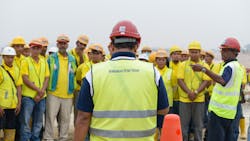Process Safety: Prepare For The Worst
Several years ago, I fulfilled a lifelong ambition of learning to scuba dive. My path to certification wasn’t smooth, but it makes for a great story of endurance and overcoming adversity. I was working at a refinery at the time. It was a high-stress role, and I was looking for an escape. I took a vacation to Fiji for a week and decided to learn to dive while I was there. I did my theory work and all my confined water sessions. It was all going well, and I was looking forward to my first open-water dive of the course. We got our kit together and headed to the boat. There was a gentle swell of about 3 ft. We would be diving on the reef just offshore from the resort. Three of us were on the boat: the boat driver, my instructor and me.
Whenever you undertake a higher-hazard activity, you must ensure you have planned for the unexpected and have mitigation steps in place. In the workplace, this is like having emergency-response plans and emergency equipment on standby. For example, during hot-work activities, you have a fire watch in position with firefighting equipment. You need to train and exercise your employees on emergency response so their response is second nature.
So, how does this relate to me learning to scuba dive? We set out from the dock and to the outside of the reef. The gentle swell was no concern. We were getting ready to dive, so my instructor and the boat driver were at the bow preparing the dive flag. I was sitting quietly at the back of the boat with all my equipment on: buoyancy control device with tank and regulator on, weight belt, mask and fins. I was thinking about the dive brief and the skills I needed to show the instructor. Something made me look out the back of the boat. I saw a wall of water coming at me. I had to look up to see the top of the wave; it was almost 12-ft. high. At that moment, all I had time to do was put my arms over my head as the wave engulfed the boat. I was washed up to the bow as the boat capsized, and I became entangled in some ropes inside the rope locker. My mask, while still on, was full of water, and I had no air.
This is where training and exercising emergency response skills paid off. I was able to use a little bit of air from my lungs to clear the water from my mask – I could at least see. This helped me find my way out and kick to the surface for a much-needed breath. However, I was still tangled in ropes. My instructor surfaced nearby and came over to me, located my regulator and put it in my mouth so I had air available to me, then started to untangle me. I wanted to remove my weight belt to get more buoyancy, but he said no, we might need to descend to swim away from where the waves were breaking. As he continued to untangle me, the next wave struck; I was dragged across the top of the reef, with my fins being swept off. We were finally able to descend and swim away from the waves, though I had no fins and was bleeding from coral cuts all over my legs and feet. A nearby fishing boat came to our rescue. I arrived home a few days later, determined not to be beaten by my experience. I went on to qualify as a diver, become a scuba instructor and a cave diver (there aren’t any waves in caves).
I had been trained in clearing my mask of water, managing my buoyancy and weight belt and the importance of breathing through the regulator. All these skills were taught to me, and I practiced them until they were second nature. It was these skills that saved my life that day. What are the critical safety skills your workforce needs to prepare for and manage the unexpected? How are you training your people? How are they practicing their skills? One day, it might mean the difference between life and death.
About the Author
Trish Kerin, Stay Safe columnist
Director, Lead Like Kerin
Trish Kerin is an award-winning international expert and keynote speaker in process safety. She is the director of Lead Like Kerin Pty Ltd, and uses her unique story-telling skills to advance process safety practices at chemical facilities. Trish leverages her years of engineering and varied leadership experience to help organizations improve their process safety outcomes.
She has represented industry to many government bodies and has sat on the board of the Australian National Offshore Petroleum Safety and Environmental Management Authority. She is a Chartered Engineer, registered Professional Process Safety Engineer, Fellow of IChemE and Engineers Australia. Trish also holds a diploma in OHS, a master of leadership and is a graduate of the Australian Institute of Company Directors. Her recent book "The Platypus Philosophy" helps operators identify weak signals.
Her expertise has been recognized with the John A Brodie Medal (2015), the Trevor Kletz Merit Award (2018), Women in Safety Network’s Inaugural Leader of the Year (2022) and has been named a Superstar of STEM for 2023-2024 by Science and Technology Australia.

